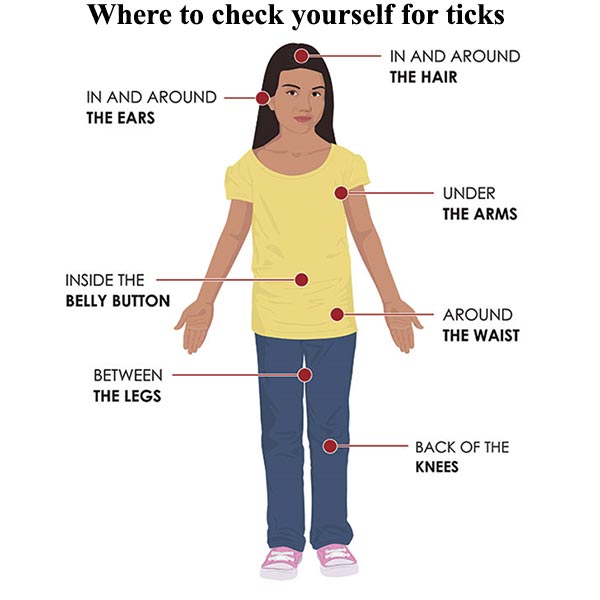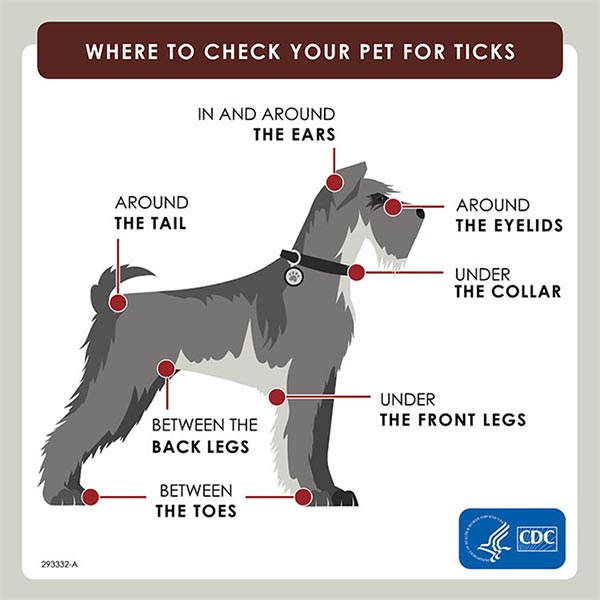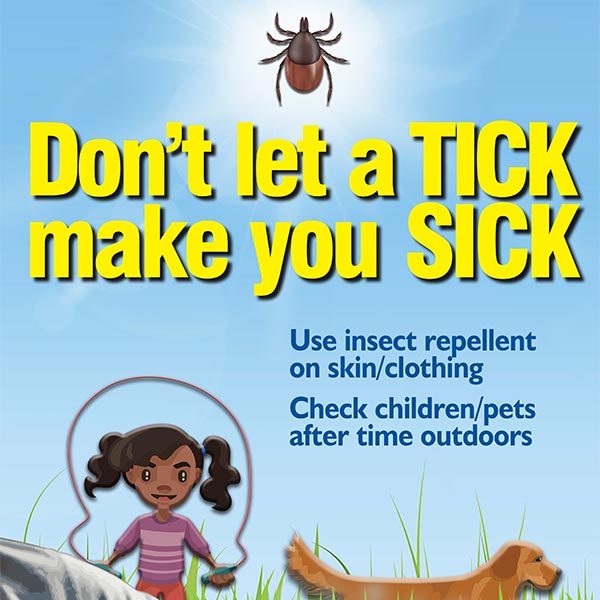News & Information
Tick Season Awareness
2021 Tick Season Awareness and Prevention
Living in an area of the state where nature’s beauty surrounds us, the residents of Sussex County face unique health concerns that some other regions do not think about as often. Tick-borne illnesses and tick bites are often a topic of discussion for the residents here, and this summer may be one of the worst with some experts calling it a “tick time-bomb.”
The east coast recently experienced a mild and wet winter; this is the perfect environment for ticks to reproduce. The summer of 2021 has also been very warm and humid, the perfect environment for ticks to thrive. In addition to the warm weather, the recent COVID-19 pandemic has created an increase in the number of people spending time outdoors, with walking and hiking trails packed with more people than in past summers. This means that stepping into the brush or grassy areas to maneuver around others in order to keep a six-foot distance may be common. It is in these grassy areas where ticks often hide, waiting to latch onto either a person or an animal.
An increased number of tick bites because of these circumstances, may lead to an increased number of tick-borne illnesses among residents.
Since 2014, nine people in Sussex County have been diagnosed with a rare tick-borne virus called Powassan virus disease. This is a viral disease that can be transmitted by deer ticks, for which there are currently no vaccinations to protect against infection.
In most cases of Powassan virus disease, people are asymptomatic or have mild symptoms. These mild symptoms may include fever, headache, vomiting or weakness.
Although extremely rare, people with more severe cases may develop neurological issues, seizures and confusion. One in 10 of those who develop severe Powassan virus disease symptoms may die.
Even though Powassan virus disease is rare, improving safety precautions is something to consider. In a study done in Sussex County last year, 274 people were tested for Powassan virus disease, with 1% of those test results positive for the virus.
In addition to Powassan virus disease, Sussex County residents should take precautionary measures against Lyme disease, another tick-borne illness.
Between 2000 and 2018, there have been 5,426 confirmed cases of Lyme disease reported in Sussex County. It is believed that there may be many more cases of Lyme disease since symptoms are often mild. Lyme disease is transmitted by deer ticks; and symptoms may take time to develop.
After being bitten by a Lyme-carrying tick, the first 30 days can include fever, chills, headache, fatigue or a rash that surrounds the bite. This rash may expand over a period of time and may appear similar to a “bullseye.”
Symptoms may appear after these first 30 days and can include severe headaches and stiffness, additional rashes, loss of muscle tone in the face, pain throughout the body and even swelling of the brain and spinal cord.
Some COVID-19 and Lyme disease symptoms are similar, which may cause issues in Lyme disease detection and diagnosis. Respiratory issues are one of the symptoms often present with COVID-19 and not Lyme, which may help to differentiate between the two.
If you or a family member have been bitten by a tick or display any of these symptoms, it is advisable to contact your primary care physician.
To Prevent Illness Related to Tick Bites
Both Powassan virus disease and Lyme disease are transmitted by tick bites. A study of Sussex County residents conducted in 2019 found that 72% of people found ticks crawling on them.
Ticks are most often found in wooded and grassy areas. Spending time in the woods, gardening, hiking or hunting can increase your risk of coming in contact with ticks. During the COVID-19 pandemic, while continuing to follow CDC guidelines on social distancing in public locations where ticks may be present, it is also important take precautions to prevent tick bites.
Some things you can do to prevent tick bites:
- Use bug spray that contains DEET
- Wear pants and long sleeves while walking, gardening, hiking, biking and enjoying other outdoor activities
- Avoid areas with high grass
- Walk in the center of trails
After exposing yourself to the outdoors:
- Check your body for ticks and if needed, ask assistance from a trusted friend or family member, as ticks may hide in hard-to-see, warm and moist areas on the body, such as behind the knees.
- Wash clothes worn while out in potentially tick-exposed areas in hot water, then follow up if possible, with the clothes dried on the high-heat cycle.
- According to the CDC, showering within two hours of returning home may be a preventative measure against Lyme and other tick-borne diseases, by washing away unattached ticks and enabling individuals to perform a tick check.

Photo from CDC
Pets and Tick Bites
Not only can humans be bitten by ticks and develop tick related illnesses, but so can pets or other animals. Dogs are very susceptible to tick bites or tick-borne diseases. Sadly, vaccines are not available for most of the tick-borne diseases that dogs can get. Tick bites on dogs can be hard to spot, so it is best to monitor your dog and their behavior if you believe they were possibly exposed to ticks.
It is smart to ask your veterinarian which tick prevention products are the best for your dog in your area. These can include medications or sprays that keep fleas and ticks away. Cats on the other hand, are very sensitive to many chemicals. Before using tick prevention products on your cat, ask your veterinarian if they think it is right for them.
Using a tick prevention product can help keep your pet from bringing ticks into the home. It is also smart to run a flea comb through their hair before entering the house to ensure that your dog or cat does not bring any unwanted pests inside.

Photo from CDC
To further reduce the chances that your pet may contract a tick-borne illness check your pets for ticks each day, if you find a tick remove it right away, and ensure your yard and space are not somewhere ticks thrive.
For More Info visit:
Tick Removal: https://www.cdc.gov/ticks/removing_a_tick.html ![]()
Powassan Virus Disease: https://www.cdc.gov/powassan/index.html ![]()
Lyme Disease: https://www.cdc.gov/lyme/index.html ![]()
How ticks spread disease: https://www.cdc.gov/ticks/life_cycle_and_hosts.html ![]()
Pets and Ticks: https://www.cdc.gov/ticks/avoid/on_pets.html ![]()
Posted April 30, 2020
May 2020 Tick Season Awareness and Prevention
Exposure to ticks can happen at any time of the year, but ticks are most active during the warmer months - from April to September. Now is the time to educate yourself and your loved ones about the risk of contact with ticks.
Ticks are generally found near the ground, in brushy or wooded areas. They will climb onto a host and find a site to attach to the person's or animal's skin. Once a tick is attached to the skin, it will slowly suck the blood. If the tick contains a pathogen, it may be transferred into the host person or animal and make them sick.
Lyme disease is the most common tick-borne disease in New Jersey. Other diseases caused by ticks include Anaplasmosis, Babesiosis, Ehrlichiosis, Powassan and Rocky Mountain spotted fever. Untreated, these diseases can cause a wide variety of symptoms:
- Skin rash
- Erythema migrans (EM) rash - specific to Lyme disease; also known as the "bull's-eye"
- Tiredness or dizziness
- Fever or chills
- Headache, muscle aches, joint pain, stiff neck
Prevention
- Wear clothing that covers the arms and legs and tuck pants into socks so ticks cannot come in contact with the skin. Wearing light-colored clothing can help to see if a tick is on the body.
- Use Environmental Protection Agency (EPA)-registered insect repellents. Treat clothing, boots, socks and tents with products containing 0.5% permethrin. The EPA's repellent search
 can help you find the right product for your needs.
can help you find the right product for your needs. - Treat dogs and cats for ticks based on recommendations by a veterinarian.
- Check for ticks every day. Look under the arms, on the back, around the ears and waist, in the belly button, behind the knees, between the legs and on the hairline and scalp.
- Shower soon after being outdoors.
- Avoid tick-infested areas.
Removal
- Use fine-tipped tweezers to grasp the tick. Try to get as close to the skin's surface as possible. The key is to remove the tick as soon as possible.
- Pull upward and don't twist or jerk the tick - parts of the tick can break off and stay in the skin.
- After removal, clean the bite area and hands with rubbing alcohol or soap and water.
For more information about ticks, visit www.cdc.gov/ticks ![]() and for information about Lyme disease, visit https://www.state.nj.us/health/cd/topics/lyme.shtml
and for information about Lyme disease, visit https://www.state.nj.us/health/cd/topics/lyme.shtml ![]() .
.


